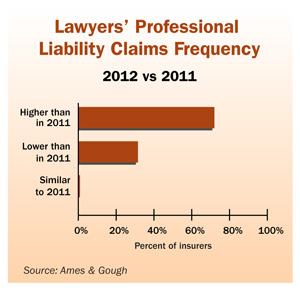Leading legal malpractice insurers experienced a deluge of claims in 2012, including those in excess of $50 million, made up of complex lawsuits that originated during the economic recession of 2007 to 2009.
A 2013 study by broker Ames & Gough surveyed seven insurance companies representing a large majorityof the marketplace finds 71 percent of participants had a year-over-year spike in new claims in 2012. Forty percent experienced a 21 percent or more increase in claims frequency, and 20 percent of respondents saw an increase of 11 to 20 percent.
“There's no question that the number of large legal malpractice claims is increasing,” said Eileen Garczynski, partner and senior vice president of Ames & Gough. “The key impetus is the recession of 2007 to 2009.”
The financial crisis caused an influx of malpractice suits as companies tried to reclaim funds lost in Ponzi schemes and toxic business and real-estate transactions. When suits against other financial parties didn't recover their losses, many opted to sue their legal counsel. Additionally, the financial crisis ushered in more M&A activity.
“Today, there's no question law firms are operating in an intensely competitive landscape,” said Garczynski. “The imperative for survival and the drive for growth are leading to more firm mergers and the hiring of attorneys from other firms. Unfortunately, these initiatives often bring greater risks.”
Five of the seven insurers surveyed attributed the rise in claims to mergers and lateral hires (those who work for former clients while employed at a new company), and an equal number ranked “conflict of interest” as their first- or- second- most frequent malpractice claim. At least one insurer cited “failure to know/properly apply law” and “failure to file [on time]” as their most frequent alleged error.
The real estate industry was the greatest malpractice-claim generator in the study for the third year in a row, followed by corporate business organization and securities and estates.
The spike in claims is taking a toll on insurer capital: in 2012, six companies increased the rates they pay their defense counsel. Four of seven now pay $300 to $401 per hour for defense counsel, while in 2011 only two paid this rate.
Garczynski said that in 2008 and 2009, Legal Malpractice insurance was commonly written at a steady rate with comfortable capacity, but due to claims volume the rates for this coverage are now rising by 7 to 10 percent.
“While the lawyers' professional liability landscape and the claim environment continue to evolve, one thing is certain,” Garczynski said. “Solid risk management and active claims monitoring are more critical than ever and can pay off – both in terms of helping firms reduce the likelihood of malpractice suits and keeping rising insurance costs under control.”
Garczynski advises, “Ask attorneys for documentation of their former firm's insurance coverage. Make sure they report any potential claims related to their prior work to their former firm's insurer. And be sure they disclose fully any past work or carry over work when joining their new firm.”
Want to continue reading?
Become a Free PropertyCasualty360 Digital Reader
Your access to unlimited PropertyCasualty360 content isn’t changing.
Once you are an ALM digital member, you’ll receive:
- Breaking insurance news and analysis, on-site and via our newsletters and custom alerts
- Weekly Insurance Speak podcast featuring exclusive interviews with industry leaders
- Educational webcasts, white papers, and ebooks from industry thought leaders
- Critical converage of the employee benefits and financial advisory markets on our other ALM sites, BenefitsPRO and ThinkAdvisor
Already have an account? Sign In Now
© 2024 ALM Global, LLC, All Rights Reserved. Request academic re-use from www.copyright.com. All other uses, submit a request to [email protected]. For more information visit Asset & Logo Licensing.








